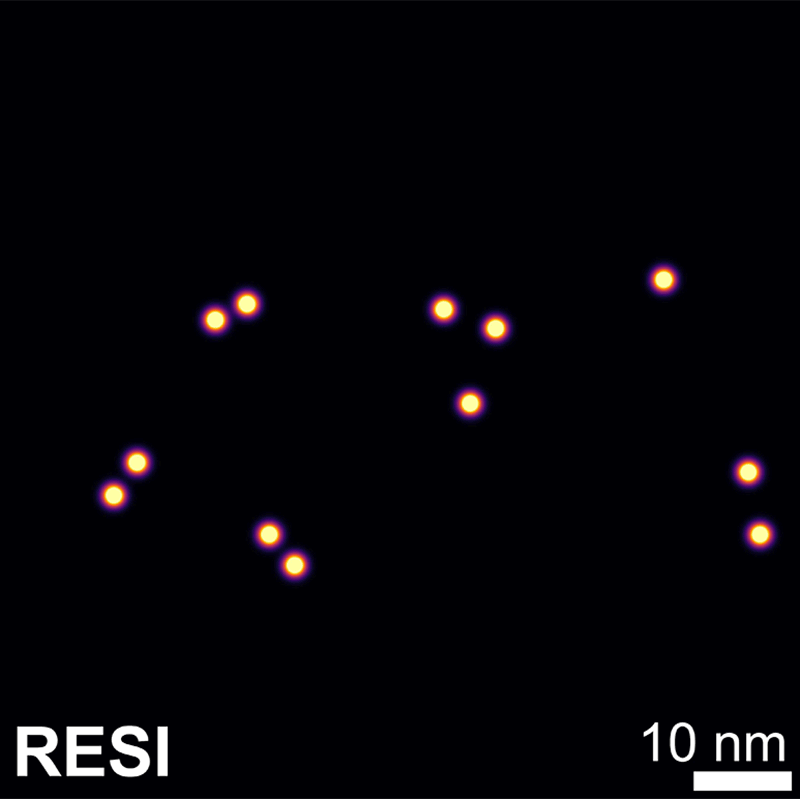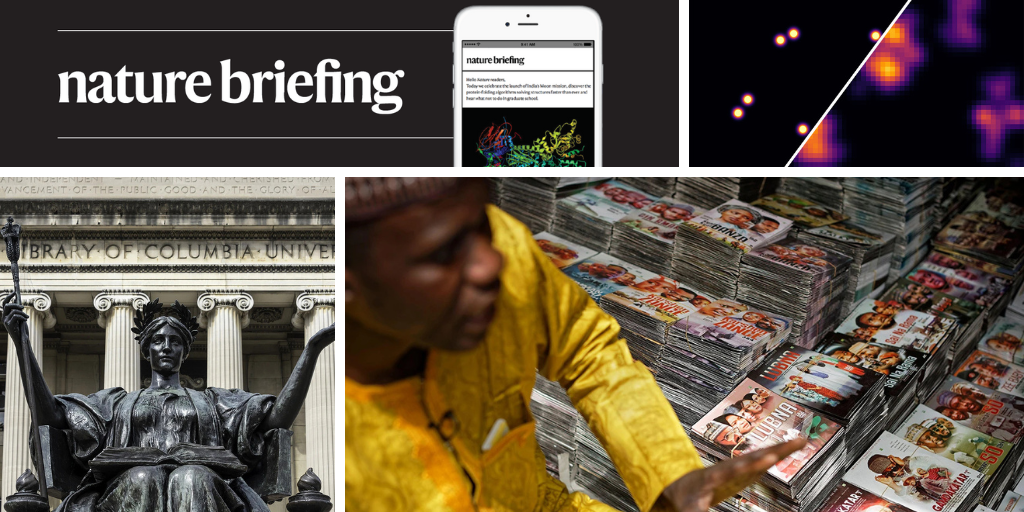You have full access to this article via your institution.
Hello Nature readers, would you like to get this Briefing in your inbox free every day? Sign up here.

The novel 0.9-nanometre-resolution RESI imaging discriminates between molecules on a human cell membrane much more sharply than an existing 7-nanometre technique. Credit: Luciano A. Masullo et al./Nat. Nanotech. (CC BY 4.0)
Using a new imaging technique, scientists have mapped individual sugars on the surface of cells at sub-nanometre resolution with a humble light microscope. Light microscopes usually blur structures smaller than 200 nanometres. The new technique has revealed the sugary structures at a resolution of just 9 Ångström, or 0.9 nanometres, outperforming even the best previously available super-resolution light microscopy tools. “The next step is to understand how these sugars on the cell surface change during health and disease,” says biophysicist and study co-author Karim Almahayni.
Reference: Nature Nanotechnology paper
Language specialists have recorded 9,000 hours of people speaking 18 African languages and transformed the recordings into digitized language data sets. The group plans to release the data to the developers of artificial intelligence tools to use to train large language models (LLMs). Many LLMs are used to convert speech to text or provide automatic language translation, but a lack of training data for African languages means these tools can’t recognize them. Languages being recorded include Hausa, Yoruba, Igbo and Naijá.
Scientists at Columbia University say they’re relieved, yet unsettled, after the institution reached an agreement with the US government to restore its research funding in exchange for an increase in federal oversight of the institution. The settlement means that Columbia will pay more than US$200 million to the government over three years to end multiple federal investigations that revolve mainly around allegations of antisemitism on campus. Despite scientists’ relief over the restored funds, many worry about the precedent that the deal sets, including the extra scrutiny of international applicants.
Features & opinion
First sketched out a century ago, the equations at the heart of quantum mechanics underpin technologies from computer chips to medical-imaging machines. But no one seems to agree on how best to describe the physical reality that lies behind the maths. A Nature survey of more than 1,100 researchers — the largest ever on the subject — has revealed just how widely researchers vary in their interpretations of the most fundamental features of quantum experiments, and their confidence in their answers.

Opinions on whether a boundary exists between classical and quantum objects were split almost exactly down the middle.
“I don’t think anyone has quite matched him before or since for his clever yet extremely informed mathematical and scientific lyrics,” says mathematician Marcus du Sautoy of satirical singer-songwriter and mathematician Tom Lehrer. A prodigy, Lehrer went to Harvard University at 15 years old, and later graduated with a degree in mathematics. What followed was a one-of-a-kind career in which he juggled science and the stage. His song ‘The Elements’ has “made a tremendous impact on the popularization of science, chemistry and of course the periodic table”, says science historian Eric Scerri. Lehrer has died aged 97.
For three days in June, biologists gathered in Prague, and a nearby wooded campsite, for a biology conference like no other. At Woodstock Bio2 + Night Science, the aim was “to reimagine science in a non-bureaucratic, non-boring way”, says molecular biologist and conference co-organizer Oded Rechavi. Attendees spoke in five-minute slots — some in rhyme, others supported by spontaneous dance — and were called to the podium in random order. The silliness “sets the tone for a very open conference where we can be very authentic”, says plant biologist and conference co-organizer Natanella Illouz-Eliaz.
Today, along with ‘The Elements’ by Tom Lehrer, I’m enjoying another parody of Gilbert and Sullivan’s ‘I Am the Very Model of a Modern Major-General’. Tom Freeman, editor of the blog Stroppy Editor has penned an AI-inspired version: ‘The Largest Language Model Anyone Could Ever Need’.
Perhaps these ideas come more easily to people called Tom than the rest of us.
If you have a favourite science-parody song, please do send it, along with any feedback on this newsletter, to [email protected].
Thanks for reading,
Jacob Smith, associate editor, Nature Briefing
• Nature Briefing: Careers — insights, advice and award-winning journalism to help you optimize your working life
• Nature Briefing: Microbiology — the most abundant living entities on our planet — microorganisms — and the role they play in health, the environment and food systems
• Nature Briefing: Anthropocene — climate change, biodiversity, sustainability and geoengineering
• Nature Briefing: AI & Robotics — 100% written by humans, of course
• Nature Briefing: Cancer — a weekly newsletter written with cancer researchers in mind
• Nature Briefing: Translational Research — covers biotechnology, drug discovery and pharma


